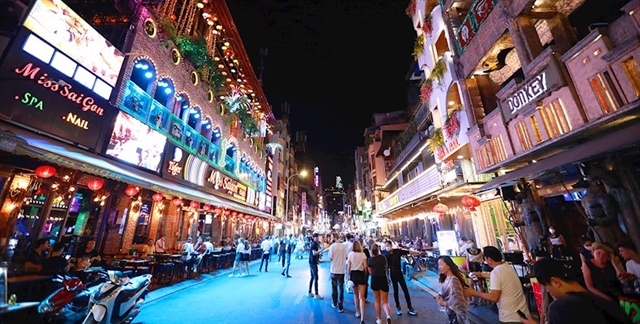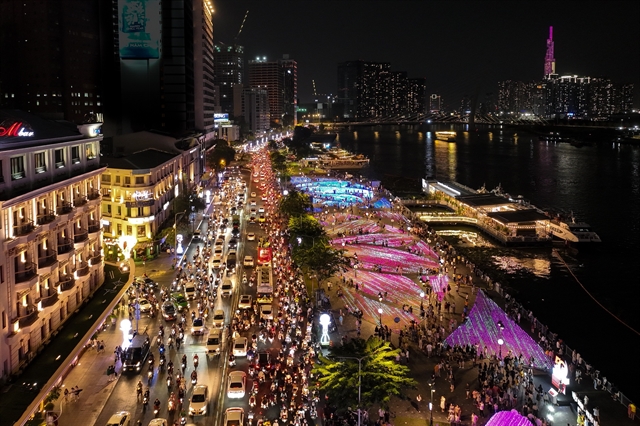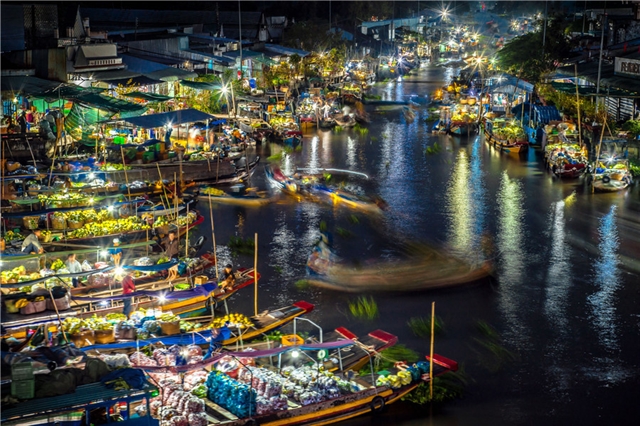Weather:
- Ha Noi 25oC
- Da Nang 28oC
- Ho Chi Minh 27oC

Việt Nam’s tourism sector is expected to shine brighter, with a growing focus on the night-time economy in HCM City and provinces across the Mekong Delta.
Night-time activities such as entertainment, cultural performances, and culinary experiences, taking place from 6pm to 6am, are collectively known as the night-time economy.
These activities play an important role in boosting revenue and driving economic development, particularly in the tourism and service sectors across various localities.
While the benefits are already evident, experts and policymakers believe that specific, tailored solutions are needed to further develop unique and high-quality products and services within the night-time economy.
These solutions should harmonise the interests of all parties involved and help promote tourism as a contributor to broader socio-economic development.
Advantages for growth
In many places, especially urban areas with thriving tourism and service sectors, models and activities within the night-time economy have demonstrated their strong appeal.
HCM City, Việt Nam’s most dynamic tourism hub, has in recent years seen the rise of numerous streets dedicated to night-time food services, shopping, and cultural performances.
These include pedestrian areas and night promenades that have become magnets for both locals and tourists.
Notable names include Nguyễn Huệ Pedestrian Street, Nguyễn Văn Bình Book Street, Bến Thành Market, Hồ Thị Kỷ Market, Bùi Viện Street, Vĩnh Khánh food street, commercial centres, and health and beauty service establishments.
According to the HCM City Department of Tourism, the city offers a wide range of night-time tourism products, such as city sightseeing, cultural exploration, art performances, and culinary tours, all well-received by visitors.
Several tours are designed specifically to provide night-time experiences through culturally rich wards and areas such as Sài Gòn, Tân Định, Bến Thành, Cầu Ông Lãnh, and even coastal areas like Vũng Tàu, Tam Thắng, and Rạch Dừa wards.
HCM City’s vibrant nightlife and poetic riverfront charm are key attractions for both domestic and international visitors.
According to Nguyễn Hoàng Long from Nguyễn Tất Thành University, night-time tourism in HCM City is developing rapidly and becoming a key tourism product in Việt Nam.
These night-time experiences especially appeal to younger travellers who seek novel and unique activities, helping solidify the city’s reputation as one of Việt Nam’s most energetic and internationally recognised destinations.

Beyond the big city
Elsewhere in the Mekong Delta, some provinces have begun to offer nighttime attractions.
In recent years, Đồng Tháp Province has emerged as a budding evening destination.
Nguyễn Hồng Mai, a visitor from Hiệp Bình Ward in HCM City, says that while it used to be difficult to find nighttime activities when staying overnight in Đồng Tháp, that is no longer the case.
With the merging of the former Đồng Tháp and Tiền Giang provinces into the new Đồng Tháp, tourists can now enjoy evening walks and night markets, especially on weekends.
Signature dishes like Mỹ Tho-style rice noodle soup in Mỹ Tho Ward, Sa Giang rice crackers in the wards of Sa Đéc and Cao Lãnh, and other traditional cakes at local night markets are now part of the local night experience.
While still limited in scale, these offerings add a distinctive touch to the province’s tourism landscape.
Tailored solutions needed
As localities across Việt Nam implement new socio-economic strategies and administrative mergers open up new development opportunities, each region with tourism potential is formulating strategies for tourism and service development, including night-time offerings.
Bùi Hoài Sơn, member of the National Assembly’s Committee for Culture and Education, says that research has shown tourists tend to spend more money at night, and that night-time tourism products have their own special appeal.
Under the enchanting glow of lights, historical sites become more engaging with the help of modern storytelling technologies, and cultural activities take on new life, making them more attractive and accessible to visitors.
As HCM City positions itself to become a new mega-urban area in the southeast region, its natural, geographic, and infrastructural advantages continue to favour tourism and services as key economic sectors.
However, Long points out that many challenges remain in optimising night tourism in the city.
Some entertainment services still fail to meet the expectations of international tourists.
High population density and traffic congestion, especially during peak hours, can complicate movement between attractions and negatively affect visitors’ itineraries.
Therefore, improving nighttime urban management is the first priority.
The city authorities are also urged to invest more in infrastructure, improve lighting, upgrade roads, and add public facilities like parks, lakes, and recreation areas.
Developing unique and diverse night tourism products will require creativity and investment in ideas such as sunrise-viewing tours, night shopping, and street art performances.

Future of night tourism
According to the HCM City Department of Tourism, boosting the night-time economy through engaging experiences is a strategic priority.
The city is carrying out pilot programmes for night-time museum openings, combined with traditional performing arts and fashion shows.
At the same time, investments in waterway tours are being expanded to create compelling night-time experiences for visitors.
Nguyễn Quốc Nghi, PhD from Cần Thơ University, believes the potential for night-time economy products is far from exhausted.
He emphasises the importance of incorporating cultural and intellectual depth into night-time services, suggesting that Cần Thơ, being the central urban area of the Mekong Delta, should capitalise on its vibrant, multi-layered cultural heritage.
The city is encouraged to continue shaping a night-time economy model suited to its strengths and local conditions while aligning with the needs of key tourist segments.
Identifying strategic areas and streets for night-time development and aligning them with existing tourism infrastructure will be crucial.
Local authorities should work with experienced businesses and prioritise traditional cultural and artistic activities that enhance the visitor experience.
From the bustling nightlife of HCM City to the emerging evening scenes in Đồng Tháp and Cần Thơ, the night-time economy holds enormous potential for Việt Nam’s tourism industry. VNS

